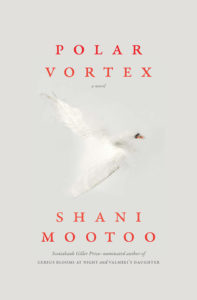April 15, 2020
Books on the Radio
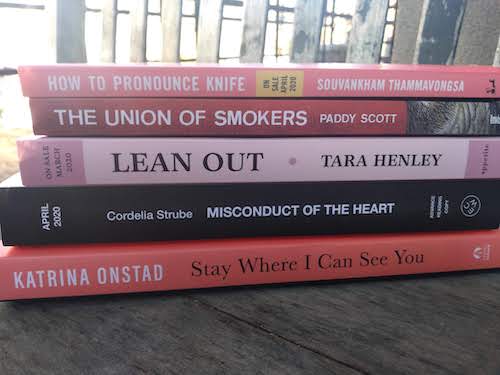
Books are giving me life right now, at a moment when life itself is kind of thin, and so it was a pleasure to speak on CBC Ontario Morning today about five books that have been good for my spirits lately, as inspiration, distraction, and reasons for hope. You can listen again to my recommendations here—I come in at 44:30.
April 9, 2020
A Conversation With Tara Henley

Like many of you, I found myself unable to read as this crisis arrived in our lives, perpetually in a panic, scrolling news feeds instead. Not being able to read, however, only compounded the trouble I was in, because if I’m not a reader, then who am I? And it was Tara Henley’s new memoir LEAN OUT: A MEDITATION ON THE MADNESS OF MODERN LIFE that brought me back to books again, a gorgeously written memoir that is perfectly timed for our current moment. Henley was kind enough to answer some of my questions about the book, so please read on to learn about how Madeleine L’Engle’s books expanded her vision for her life, what are the limits of self-care, and how “right now we’re seeing in stark terms the price we all pay for inequality.” I love this book so much.
April 8, 2020
How to Pronounce Knife, by Souvankham Thammavongsa

Make your book pink. Make your book slim. Put a nail file on the cover, and have your reader forget that it’s actually a blade, and this is how you do it, create a story collection that seems unassuming but will cut you with its razor edge. The “Yes, Sir” delivered in a tone that really means, “Fuck you!” And it gets under your skin, of course, a book like this, Souvankham Thammavongsa’s fifth book after four acclaimed poetry collections and her debut fiction, the short story collection How to Pronounce Knife. (Full disclosure: the writer and I were classmates twenty years ago, and I since followed her career with admiration.)
These stories are subtle, wonderful and jarring. They range between those from the perspective of children of immigrant families from Laos (reflective of Thammavongsa’s own background), children who are know before many of their classmates the way that parents are actually fallible after all, that they struggle and have limits, and stories of people awkwardly navigating social and romantic mores, failing to fit in with convention (which is another way of not failing at all—especially in a story).
In the title story, a child takes her father’s guidance on the correct way to pronounce “knife,” and learns the lessons of a lifetime in the process. In “Paris,” a woman who works in a chicken factory dreams of getting a nose job—and experiences vicarious heartbreak. A seventy-year-old woman has an affair with her young neighbour in “Slingshot,” a story with the most perfect, powerful ending.
I LOVED “Randy Travis,” the story of a family who immigrates from Laos, and the mother falls in love with country music, which helps define for her a different kind of life she desires for herself. In “Mani-Pedi,” a failed boxer who ends up with no choice but to take a job at his sister’s nail salon—but who insists on keeping his dreams. “Chick-a-Chee” is about one family’s embrace of a bizarre local ritual. “The Universe Would Be So Cruel,” awesome and heartbreaking, about a man who runs a small print shop and has an uncanny knack for knowing the future for the couples whose invitations he creates. A child considers the mystery of her mother in “The Edge of the World.” A school bus driver realizes he’s losing his wife in “The School Bus Driver.” A mother watches her daughter from afar in “You Are So Embarrassing.” The story “Ewwrrrkk” begins, “The summer I turned eight, my great-grandmother showed me her boobs.” An accountant looks for love (and potential clients) in “The Gas Station.” A childhood friendship is recalled in “A Far Distant Thing.” And a young girl goes to work with her mother in the final story, “Picking Worms.”
The stories are quiet but powerful, the sentences extraordinary, the volume as a whole is such a pleasure to read and to discover.
April 2, 2020
No More Nice Girls, by Lauren McKeon, and Lean Out, by Tara Henley
Although almost everything I was reading a month ago seems kind of irrelevant now, Lauren McKeon’s No More Nice Girls feels like it could be an exception. This underlined by the number of Canadian politicians and public health officials who are women and spearheading efforts to fight and control what’s going on right now, women we are turning to for answers and reassurance, one of whom, Deputy Prime Minister Chrystia Freeland, shows up early in McKeon’s book as as “a new kind of power that’s completely, deliberately at odds with a very old, very masculine one.”
In her book, McKeon imagines what might be possible with a different kind of power, and writes about ways that people are imagining such things already, with all-women co-working spaces, the #MeToo movement, “identity politics of lonely, angry men” as a backlash to women’s power. She writes about how conventional power doesn’t tend to work for women when they achieve it, corporate achievement as an example, where the women at the top still have to contend with the same challenges that all women do—sexism, harassment, discrimination, violence, a gender pay gap. The ways in which women have to be “better than perfect” to be accepted, while any guy in a poor fitting suit seems to fit the bill. And the limits of #GirlBoss kind of power, which is the kind of individualized, status-quo sustaining power that the patriarchy likes.
It’s difficult to synopsize McKeon’s book, whose range is so wide. She writes about race and representation; economics and federal budgets; gender and the media; how technology affects our lives and what it means that so much of technology is created by men; feminist cities; online trolling (McKeon is author of F-Bomb: Dispatches from the War on Feminism, which I read and loved in 2017); and about numerous and inspiring ways that women all over the world are raising the bar and changing the narrative on traditional notions of what a life of a woman ought to look like. It’s an incisive and inspiring read.
*
I read No More Nice Girls in “the before times” and then was unable to read anything properly for a couple of weeks, as the world before my eyes was changed into a surreal and disturbing reality. And the book that finally brought me back to reading was Tara Henley’s Lean Out: A Meditation on the Madness of Modern Life. (Full disclosure: Henley wrote a kind and generous review of my novel back in 2017. We also share an editor. Neither of these factors are why I’m so obsessed with her book, but are definitely worth noting.)
Reader, this book was a balm, as it was always meant to be—but it meant so much more than it would have even a month ago. Suffering from physical symptoms of anxiety in 2016 after a decade of living in the big city and working in journalism, Henley reached a breaking point and realized that things would have to change—but also that she was limited as to what change was possible to her as an individual, this becoming even more apparent after she moves back to her hometown Vancouver and is confronted with the city’s unaffordability. Does modern life truly have to be like this, Henley wonders? A less solipsistic Eat, Pray, Love is how I am thinking about this book.
Lean Out is rich with reporting, but underlined by Henley’s own story and family history. (It’s also gorgeously written and inspired by the works of Madeleine L’Engle, which meant a lot to me after My Year of Vicky Austin.) She writes about alternatives to the way we do work, connect with nature, eat food, make and spend money, live online, combat loneliness, find community, and make our homes. Arriving at not definitive answers, but instead broadening the range of what is possible for a more fruitful way of living both as individuals and as a society. And, as with McKeon’s book, it all comes down to inequality in the end—data shows that unequal societies, Henley writes, make life demonstrably worse for everybody, even those who are at the “top.”
Which is something all of us should keep in mind as we think about what kind of world we want to live in “when all this is over.” I am so grateful to these authors who are already doing the work of imagining new and better ways of being.
*Both these books are included on a Books With Vision list I created at 49thShelf. And an amazing Q&A with Henley will be up on 49thShelf in about a week. Stay tuned. And buy her book in the meantime—you will be glad you did.
March 5, 2020
Polar Vortex, by Shani Mootoo
At first glance, this is a novel about a love triangle. Priya, who is married to Alex (a woman), and they live together in quaint and rural Prince Edward County. But something isn’t right, even before we learn that their household is about to be disturbed by a visit from Priya’s old friend, Prakash. Even notwithstanding Priya’s erotic dream about Prakash, which opens the novel. There is a distance that stands between Priya and her wife, and also a strange, uncanny hollowness to Priya’s first-person narration—or maybe it’s not hollow, but instead there’s a kernel of something there (what?!) that the reader is not privy to.
Prakash is a very old friend, a friend that Priya has barely spoken of to Alex, though she has pointed him out in an old photo from university, a photo of the two of them alongside Priya’s first girlfriend, Fiona. And is Alex threatened because he shares a cultural heritage with Priya? They are both diasporic Indians, Prakash from Uganda (where his family was expelled and brought to Canada as refugees) and Priya from Trinidad—though Priya would argue that this isn’t such a remarkable connection. But of course there is more to it, more than even Alex knows, more than Priya is willing to admit to herself or to even remember.
The novel takes place over the course of a day, and the tension in the text can be excruciating—but in the very best way. The kind of excruciating tension that makes a book unputdownable, that causes a reader to yell at a page. Polar Vortex becomes a book about truth and memory, about how little we know each other, and ourselves. Strange, ominous, haunting, it’s a propulsive read and a deliciously unsettling one.
March 4, 2020
March Books on the Radio
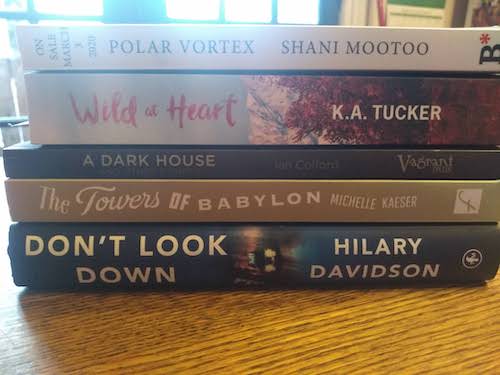
So happy to talk GREAT BOOKS on the radio this morning with the lovely Wei Chen, who even reads the books I recommend. If you missed it live, you can listen again on the podcast. I come in at 35.00.
February 28, 2020
Disfigured, by Amanda Leduc
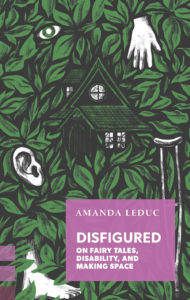
While I was intrigued by the premise of Amanda Leduc’s Disfigured: On Fairy Tales, Disability, and Making Space, I wasn’t anticipating just how interesting I would find the book, as someone who can get through the day (for now, at least) without giving disability a whole lot of thought and who also didn’t grow up with a strong connection to fairy tales, Disneyfied or otherwise. A few years older than Leduc, I was lucky enough to make it out of childhood without ever longing to be Ariel and before the age when Disney started marketing dresses, so that if I’d ever wanted to dress up as a princess, I would have had to design the costume myself— and that is only part of the reason I never did.
But to say that I did not grow up in a culture steeped in the messages and symbolism of fairy tales, steeped in those stories, would be disingenuous, as Leduc makes clear in Disfigured. Because these stories are everywhere, and yes, they’re only stories… but they’re not only stories. And throughout those stories are representations of disability—hands and heads chopped off in Grimms’ tales that magically grow back, and dwarfs, and women without voices, and witches with crutches, hideously disfigured beasts, and changelings, plus fairy godmothers who exist to reverse one’s fortune.
Leduc, who has cerebral palsy, uses her own experiences (and the text includes her own childhood medical records) to tell a story of what it means when happily ever after means learning to live with one’s disability, instead of magically overcoming it—and suggests that what must be overcome is society’s ableism instead. Disfigured is gorgeously written, a fascinating blend of memoir, scholarship and cultural commentary, a quick read that’s also packed with stories about fairy tales and disability, as well as questions and curiosities. It’s the kind of book that illuminates the ordinary and points to possibilities for a better kind of world.
February 26, 2020
I don’t know how to resolve the Wet’suwet’en crisis, and neither do you
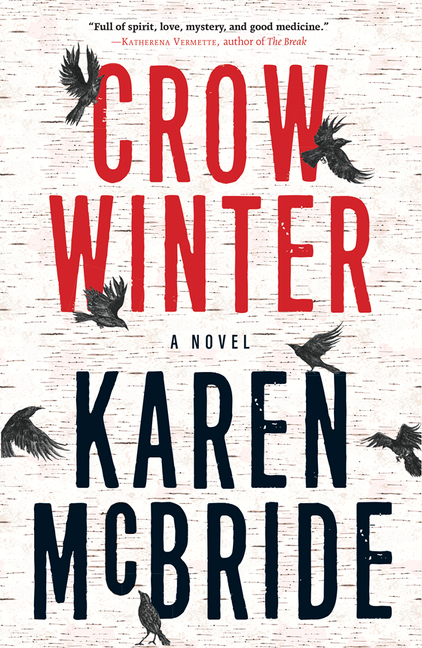
I keep thinking of something Christi_Belcourt tweeted about how impossible big corporations and government make it to resist plans they have every intention of rolling through, which we ought to keep in mind when considering the other First Nations who’ve signed on to the pipeline plan that Hereditary Chiefs of Wet’suwet’en are currently fighting in northern BC. It’s interesting to be reading Karen McBride’s novel Crow Winter as all this is unfolding, the story of a young woman who returms home to Spirit Bear First Nation in Northern Quebec and, with the help of her ancestors and the trickster Nanabush, must stop the development of a mining project on her family’s land. History is not just in the past, but it’s still happening all around us. I vote that every settler with an opinion on what’s happening in Wet’suwet’en just shut up and sit down, and read a novel instead.
February 20, 2020
A Dark House, and Other Stories, by Ian Colford
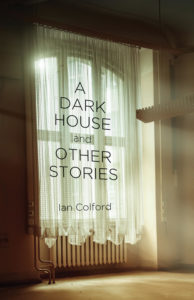
The old year clocked over on January 1, but I wasn’t finished with the books yet. A month ago I published a list at 49thShelf about 2019 books worth checking out before we got lost in a sea of 2020 new releases, and while I already suspected that it might be the least fluffy book list ever posted in the history of the internet, having read one more book from that list—Ian Colford’s A Dark House and Other Stories—I can now totally confirm it.
A Dark House… was terrific. And I’d been hearing rumours of as much; the book got a starred review in Quill & Quire. But one woman’s starred review can be another man’s DNF, so it always feels extra lucky when I like a book as much I’d been led to expect that I would.
A Dark House and Other Stories collects works Colford wrote between 15 and 25 years ago, as he explains in his acknowledgements, but nothing about these stories read like a writer who’s finding his way. The first story makes the reader feel immediately uncomfortable, about a man who has taken his son from his ex-wife. “He’s tall and gaunt and unsure what he’s doing is right, but he’s doing it anyway because what else can a man do when he’s been denied his son through a perversion of justice.” There’s a sense of inevitability here, and a real sense of empathy with somebody who has done wrong—and this pervades the whole collection. And truth be told, we’re living in a moment where a a lot of men are feeling like a perversion of justice has denied them something to which they’re entitled, and stories told from such a point of view tend to wear out my patience real fast…except that Colford writes from such a place of curiosity, grace and humanity that I kept on reading, and I am really glad I did.
The stories are gripping, plot-driven, have nothing slight about them, and decades are conveyed in just a few pages. In “The Comfort of Knowing,” a man decides to get the better of his wayward younger sister, but instead sews disaster. “The Dictator Considers His Regime” is a fascinating story that (I think) is set in mid-century Portugal, about authoritarian systems, freedom, personal responsibility, and the price of speaking truth to power. The main character in “McGowan on the Mount” reflects on a lifetime of family, loss, business, neighbourhood change, and finally can’t avoid taking one more chance on life and love. A college professor whose marriage breaks down projects his own experience onto a homely undergrad in “The Ugly Girl.” In “On the Beach,” a young girl whose mother is struggling is unnerved by her developing friendship with a troubled neighbour. In the title story, an inversion of “The Ugly Girl,” another professor projects her experience onto a student who reminds her of her ex, and reconsiders her life choices. And finally, in “The Music Lover,” a young girl struggles to keep the peace as her family falls apart.
Every story is rich and absorbing, small windows into wider worlds. With wide-ranging approaches to tone, theme, and characterization, what links these stories as a collection is simply that they’re just so good.
February 12, 2020
The Skin We’re In, by Desmond Cole
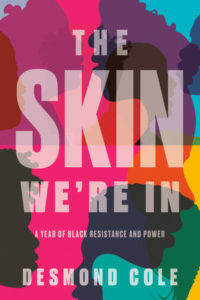
It makes sense that a writer who has insisted on blurring lines between journalism and activism would create a book that’s such a powerful blend of reporting and memoir, and it’s the extraordinary framing of his story that helps makes Desmond Cole’s The Skin We’re In a rich and enveloping read.
“A Year of Black Resistance and Power” is the book’s subtitle (except, YIKES, it almost wasn’t), and indeed, this is the story of 2017, which was two years after Cole’s Toronto Life cover story about his experiences with carding and the Toronto police force, which elevated his profile as a writer and an activist. Except that it’s not just the story of 2017, which is the book’s greatest strength, the way the single year frames the work, but Cole moves forward and backward in time to contextualize his stories, using experiences from his own life growing up Black in Canada, and also details from the historical record. In the book’s first section, he references an 18th century bylaw in Shelburne Nova Scotia “forbidding Negro dances and Negro Frolikcks in this town” in the story of Toronto artist John Samuels, whose gallery space was raided by the police and was physically attacked by them on the eve of the New Year 2017.
“White supremacy, which informs and fuels anti-Black racism, is an insatiable force White supremacy is never personal, never individual, never isolated. The historic problems I explore in this book are not a matter of some police being too rough or some government programs being too poorly funded, They have nothing to do with the political leaning of a particular government or the intentions of powerful people. We’re talking about a system of power that seeks to benefit white people above all others.”
You can’t make this stuff, I guess is what I mean. How a single year can be picked out of the air to demonstrate the ways the pervasiveness of anti-Black racism and white supremacy in Canada. In the school system—Cole gives examples of a six-year-old girl put into shackles by police, and the appalling behaviour (and even worse, refusal to accept responsibility for it) by a York Region school board trustee, and this is only February. In March, police officers across Canada rise up in support of an Ottawa police officer charged with fatally beating a man on his doorstep. In April, Cole leaves his column at the Toronto Star after being called out for his activism after demonstrating at a police board meeting, never mind that his white colleagues at the paper have been lauded for such things—and in this chapter, he connects police surveillance of Black and Indigenous people to a tradition of slavery, “suggesting that our very presence as free people on the street is suspicious and in need of investigation.”
In June 2017, Black Lives Matter Toronto blocks the Pride Parade in the city, and here Cole makes the connection between Black activists and the LGBTQ movement, especially pertaining to their relationships with police—and the way that Black people been left out from the story of gay rights, as symbolized by Blockarama, a celebration of Black queer culture since 1999, getting squeezed out of Pride events in favour of corporate sponsors. The Black Lives Matter protesters didn’t just “show up” to Pride, Cole shows, but instead they’ve always been there, and in 2017, they just insisted on finally taking up their space.
July is #Canada150, celebrating what Cole calls “this round number of colonial conquest.” He reaches back to 2011 to write about the advent of Idle No More, noting the parallels with Black Lives Matter, and explores the Indigenous resistance to Canada’s anniversary celebrations, including the tipi that was built on Parliament Hill (but not before RCMP officers had arrested demonstrators—are you seeing the theme?). Later that same month, Cole, who was born in Alberta and lived there until he was five, travels to Western Canada to learn more about police carding practices in the province, and learns that Indigenous women are disproportionately affected.
“My year had begun with news of a police attack on a young Black gallery owner,” writes Cole at the beginning of August. “I thought then about how attacks like this happen every day, that they are too common to be documented and investigated.” It was during summer of 2017 that media began reporting on Dafonte Miller who was brutally beaten with a pipe by an off-duty police officer and his brother in Whitby, Ontario. Miller sustained horrific injuries, and lost an eye, and for months, there was no investigation by the SIU, which is what’s called for when a police officer is involved in a death, injury or assault of a civilian. Cole would help bring the case to public attention, and also to the Toronto Police Services Board, where he’d be thrown out of a meeting and bring 100 protesters to another the following month. It would come out that the men accused of Miller’s assault were the sons of a veteran Toronto police officer who would be put under investigation himself for interfering with the investigation of his sons.
Not shockingly, police violence doesn’t end with the summer, and Cole writes about the way that racist police violence, to the majority of white Canadians, “is the cost of being ‘free'” And then later that September, he joins demonstrators to block one of Toronto’s busiest intersections to protest the deportation of of a wife and mother for overstaying her visa. “For as long as Canada has been a country, it has gone to great lengths to keep Black people out, and to deport thousands who arrive,” Cole writes. Slavery was legal in British North America until 1834, Cole reminds us, and he notes that the Underground Railroad ran both ways, and also that Black Loyalists who fled north at the Revolutionary War had their homes burned, were driven out of town in places in Nova Scotia.
“In October of 2017, the RCMP detained 1,755 people who had entered Quebec from New York State without permission from the Canadian government.” Cole makes a distinction between immigrants, refugees and asylum seekers in general and those who are Black, noting that “the mass arrival of Black people to Canada has historically been marked by the strictest regulation our government can design.” In the 1950s and 1960s, a demand for cheap labour brought Black Caribbean domestic workers to Canada, and racist rules would exclude them from more lucrative professions once they’d been established here. Later that month, Cole travels to North Preston, NS, to learn about racial profiling and racist stigma in that community, and the struggle for Black life in other Canadian places. (Though this bit of the book really surprised me, because I’d only heard of North Preston through Shauntay Grant’s picture book Up Home, which paints the community as such a vibrant and special place, and I love that that’s the only story I knew.)
November was when the debate finally came to a head over community policing in Toronto schools, a situation born out of rising school violence in the early 2000s, which Cole connects to a radical change (and subsequent decrease) in the school funding formula during the 1990s—which seems incredibly pertinent at a moment right now in 2020 when Ontario teachers are standing up again even more cuts to education for a system who hasn’t seen a proper investment in decades, and underlines the urgency of their fight. A cheaper solution than investment, however, was putting unarmed police officers in schools, which made schools unsafe and welcome to many Black students. In 2009, a student was arrested in his school hallway for not identifying himself to an officer. It would take years of protest, but finally in November 2017, the SRO program in the Toronto District School Board was finally abolished. (It remains in the Catholic Board).
“…so much of the public conversation surrounding our work focuses on what we call ourselves and on what right we have to speak and act as we do. People who have time for these questions are dodging much more important ones: What is the purpose of activism? What are we all responsible for in the world, whether we call ourselves activists or not?”
Cole writes about an invitation to be part of the National Black Canadians Summit, which turns out to be very much an establishment operation and committed to the status quo, which Cole is having none of. While in the company of Immigration Minister Ahmed Hussen, Cole speaks out about the risk of deportation for Abdoul Abdi, a 23 year old refugee from Somalia serving a prison term. Abdi had come under the wardship of the state at age 7, who would have been the only entity with the authority to apply for his citizenship, which never happened. That he should be deported years later to a dangerous place he barely knows (and where known members of racist skinhead organizations had served in the Canadian military two decades before, when a group of soldiers had tortured a teenage boy to death—facts that are not so far outside the frame) seems obviously immoral, wrong and dangerous. Cole had learned about Abdi from his friend, Halifax writer (and former Poet Laureate!) El Jones, who has worked with incarcerated people in Nova Scotia, and unsurprisingly they do not receive a helpful response from the Minister, but with help from other activists (“They say luck happens when opportunity meets preparation.”) continue the fight to keep Abdi in Canada, bringing the issue right to the Prime Minister.
2017 was not special. This is the point of the book. That anti-Black racism is so entrenched in Canadian society that a single year contains so many stories of its insidious threads, but it was also a turning point as Black activists met with successes and had their messages amplified. Or we might hope so—though Cole doesn’t tie the story up on a bow, or end on a note of optimism. The fight goes on. Another month, another year.


